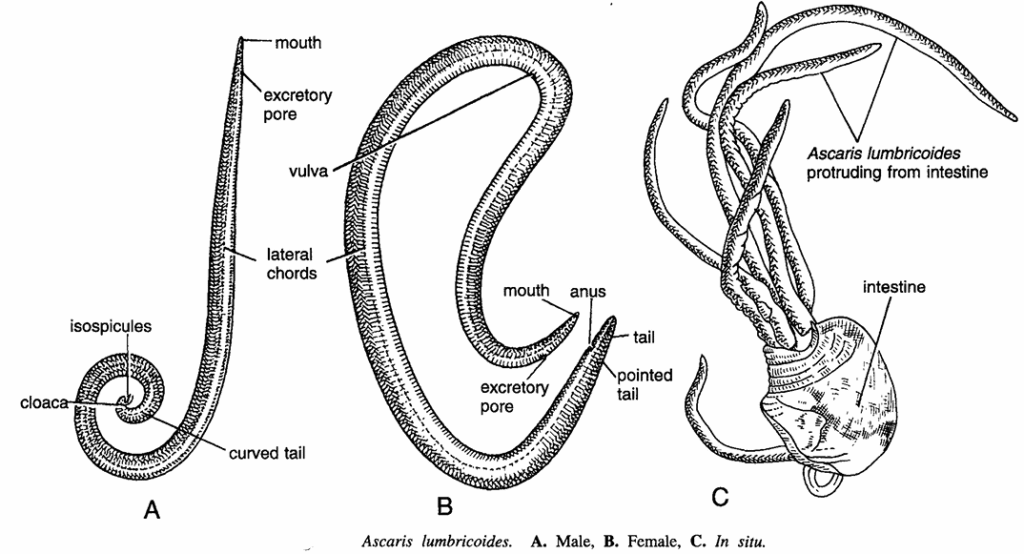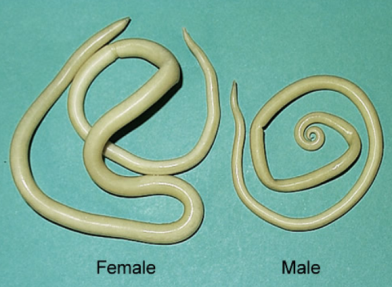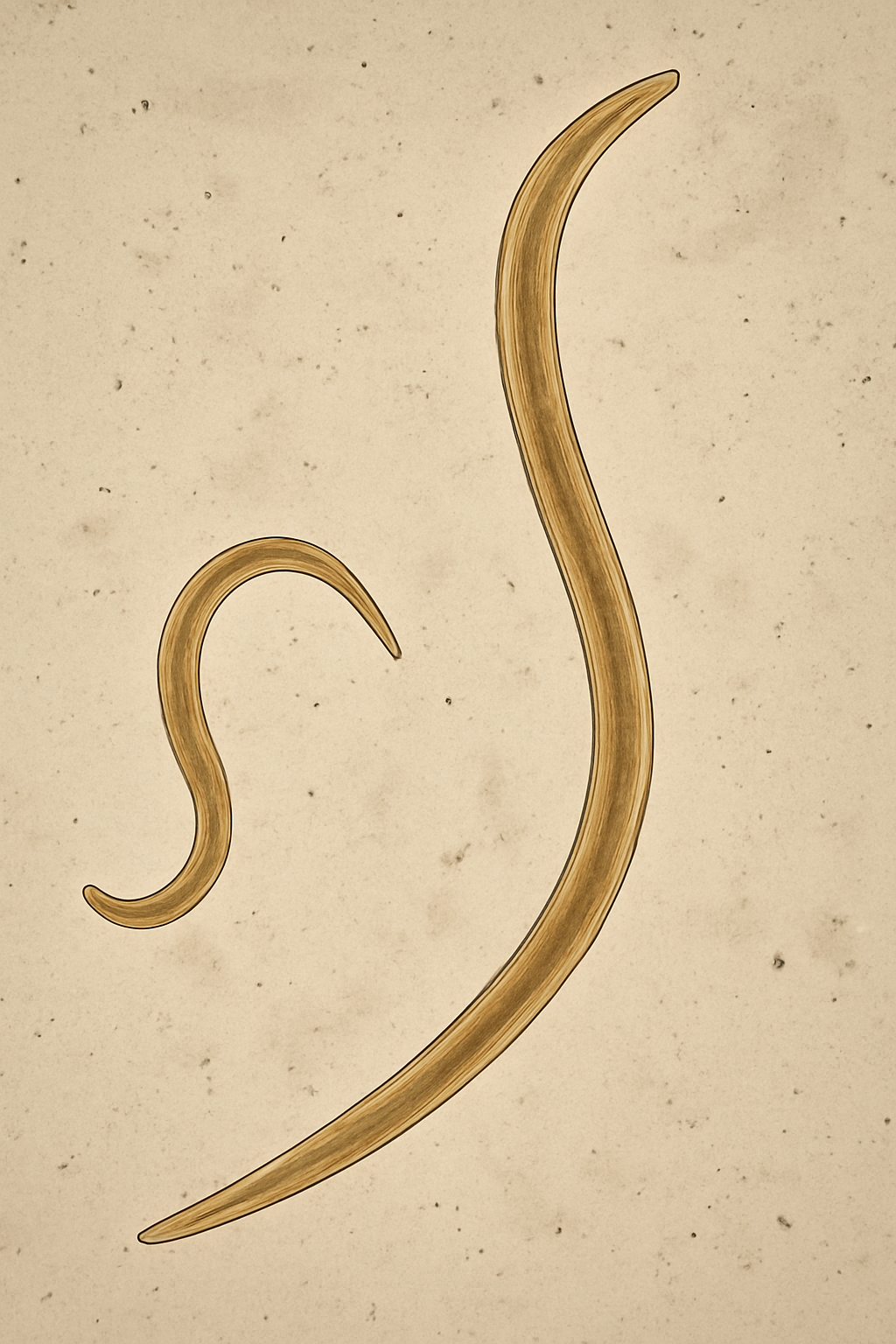Ascaris lumbricoides : Biology, Classification, Epidemiology, and Identification
Introduction
Ascaris lumbricoides is a large parasitic roundworm and one of the most common human intestinal helminths worldwide. It belongs to the phylum Nematoda and is the causative agent of ascariasis, a soil-transmitted helminth infection affecting millions, especially where sanitation is poor. This article provides a comprehensive overview of Ascaris lumbricoides, encompassing its classification, habitat, geographical distribution, general and special characteristics, identification, and relevant references for deeper study.
Ascaris lumbricoides is an intestinal nematode (roundworm) parasite that primarily infects humans. It causes the disease ascariasis, which is widespread throughout tropical and subtropical regions with inadequate sanitation infrastructure. The worm is known for its elongated cylindrical body, feeding on the host’s intestinal contents. Infection occurs through ingestion of embryonated eggs present in contaminated soil, food, or water. Although often asymptomatic, heavy infections can lead to malnutrition, intestinal obstruction, respiratory symptoms, and other severe complications. Understanding its biology, life cycle, and distribution is key to managing and controlling infections globally.
Classification of Ascaris lumbricoides
Ascaris lumbricoides is classified under the phylum Nematoda, class Secernentea, order Ascaridida, family Ascarididae. The classification with brief characteristics is as follows:
| Taxonomic Level | Name | Characteristics |
|---|---|---|
| Phylum | Nematoda | Roundworms with a complete digestive system |
| Class | Secernentea | Nematodes with lateral canals and excretory pores |
| Order | Ascaridida | Parasitic nematodes with three lips around mouth |
| Family | Ascarididae | Large intestinal parasites with thick cuticle |
| Genus | Ascaris | Roundworms with characteristic mouth lips |
| Species | Ascaris lumbricoides | Human intestinal roundworm, causes ascariasis |

Habit and Habitat
Ascaris lumbricoides inhabits the human small intestine, where adult worms reside and reproduce. The parasite depends on the host’s intestinal environment for nutrients but does not attach to the intestinal wall; instead, it moves freely within the lumen. The eggs are passed through feces into the external environment. Favorable conditions for egg development include warm, moist soil with suitable shade, which facilitates embryonation. These eggs are resilient and can survive for years in soil, supporting transmission cycles.
Geographical Distribution
Ascariasis is endemic globally, particularly in tropical and subtropical regions with limited access to safe water and sanitation. High prevalence is noted in countries across Southeast Asia, Sub-Saharan Africa, Latin America, and parts of the Caribbean. The World Health Organization estimates that over 800 million to 1.2 billion people are infected worldwide, making Ascaris lumbricoides one of the most significant neglected tropical diseases. Infection rates are highest among children due to their exposure to contaminated soil and poor hygiene.
General Characteristics
- Commonly known as Round worm. It causes ascariasis in man especially in children. Infection occurs by eating raw and uncooked vegetables.
- Shows sexual dimorphism with separate male and female individuals.
- Males measure 15 to 30 cm in length and female 20 to 35 cm.
- Tail end of male is ventrally curved containing cloacal aperture, through which two equal isospicules project.
- Tail end of female is bluntly pointed. Female genital opening or vulva found in anterior one third region.
- Anterior ends exhibit same structures in both male and female.
- Mouth is situated at the anterior extremity which is guarded by one dorsal and two sub-ventral lips.
- Amphids are found in the sub-ventral lips.
- Body is elongated and cylindrical.
- Two lateral, one mid-dorsal and one mid-ventral longitudinal chords extent from anterior to posterior end.
- Excretory pore lies at a distance of about 2 rom from anterior end.
- No intermediate host in life history.
- Body Shape: Cylindrical, elongated, tapering at both ends.
- Size: Males are smaller (15–30 cm) with curved posterior ends; females are larger (20–40 cm) with straight posterior ends.
- Cuticle: Thick, tough outer layer with four longitudinal lines.
- Mouthparts: Three prominent lips surrounding the mouth.
- Digestive System: Complete; includes mouth, esophagus, intestine, and anus.
- Reproduction: Dioecious with separate sexes; females lay up to 200,000 eggs daily.
- Eggs: Thick-shelled, oval-shaped, brownish with a coarse surface.

Special Features
- Special features : Pathogenic nematode parasite causing haemorrhage, haemoptysis, appendicitis, peritonitis, tumour, ulcer, diarrhoea, eosinophilia and death. Its infection can be avoided by not eating raw and uncooked vegetables especially grown on human night soil fertilizer.
- Ascaris infection also causes disturbances in the nucleic acid, sugar, protein and fat metabolism of the host. Sometimes intestinal human is blocked by several parasites.
- Prevention : A void eating raw unwashed and inadequately cooked vegetables and food. Contaminated water should not be taken.
- Larval Migration: The larvae undergo a complex migratory route through the liver and lungs before maturing in the intestines, a phenomenon responsible for pulmonary symptoms.
- Egg Resilience: The eggs have a resistant outer layer allowing survival in harsh soil conditions for several years.
- Size Dimorphism: Notable size difference between males and females.
- Sensory Papillae: The lip structures possess sensory papillae aiding environmental sensing.
- Host Adaptation: The parasite efficiently survives in humans, causing minimal immediate damage to maintain its niche.

Identification
Identification of Ascaris lumbricoides involves clinical and laboratory methods:
- Microscopic Examination: The most common diagnostic method is identifying characteristic eggs in stool samples. Eggs are oval, with a thick, mammillated shell and brown coloration. Fertilized eggs have a rough outer shell, while unfertilized eggs appear more elongated.
- Adult Worms: Occasionally expelled adult worms provide an unmistakable identification by their size and morphology.
- Imaging: In complicated cases (e.g., intestinal obstruction), imaging techniques such as ultrasound or X-rays may reveal worm masses.
- Larvae Detection: During the pulmonary phase, larvae may be detected in sputum samples or via blood eosinophil counts.
Life Cycle and Pathogenicity
The life cycle of A. lumbricoides begins with ingestion of embryonated eggs from contaminated sources. The eggs hatch in the small intestine, releasing larvae that penetrate the intestinal mucosa, enter the bloodstream, and migrate to the liver and lungs. After maturing in the lungs, larvae ascend the respiratory tract, are swallowed, and return to the small intestine to mature into adults. Adults reproduce, and eggs are shed in feces to continue the cycle.
Pathogenic effects range from mechanical damage caused by larval migration (leading to respiratory symptoms) to intestinal complications due to adult worms, including obstruction, malnutrition, and secondary bacterial infections.
Prevention and Control
Prevention includes improving sanitation, avoiding ingestion of contaminated food or soil, and mass drug administration programs using antihelminthic medications such as albendazole and mebendazole. Health education and hygiene promotion are essential for breaking transmission cycles, particularly among vulnerable populations like children.
References
- Byju’s – Short Notes of Biology for NEET: Phylum Aschelminthes
https://byjus.com/neet/short-notes-of-biology-for-neet-aschelminthes/ - Microbe Notes – Phylum Aschelminthes Characteristics and Classification
https://microbenotes.com/phylum-aschelminthes/ - Britannica – Aschelminth Overview
https://www.britannica.com/animal/aschelminth - CDC – Ascariasis (Ascaris lumbricoides)
https://www.cdc.gov/dpdx/ascariasis/index.html - Medscape – Ascaris Lumbricoides Overview
https://emedicine.medscape.com/article/788398-overview - ScienceDirect – Ascaris lumbricoides Summary
https://www.sciencedirect.com/topics/medicine-and-dentistry/ascaris-lumbricoides - Vedantu – Ascaris Life Cycle
https://www.vedantu.com/biology/ascaris-life-cycle
